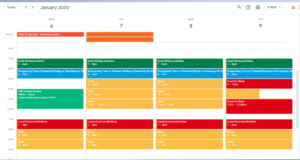Have you had the feeling of being so overwhelmed at work that your well-being, sleep, and energy levels are impacted? I find that the answer to this issue is to implement a 3-step plan. I follow this plan each year.
Step 1: Forget balance, make the right commitments.
So how do you pick the right commitments? You might be aware of Stephen Covey’s four-quadrant matrix. The matrix is split into the following four quadrants (read more about the 4 quadrants):
Everyone needs a system for figuring out how and when to make commitments. Have you ever found yourself in a place where you take on more than you can chew and you wind up not being able to fulfill everything in a good way? Or do you find yourself chasing fires? Firefighters play a vital role because if your house is burning down, you want someone brave enough to run toward the fire. For many years, I too was addicted to the last-minute rescue effort and the adrenalin rush which followed saving the day. But to guide your business and your work in a strategic way, let go of the hero complex and stop firefighting.
I have a client who has a strong rescue complex, the challenge for him has been to stop being pulled into so many projects and directions that do not enhance his core or adjacent business opportunities. Fortunately for him, he recognized this behavior and the added focus of spending his time in quadrant two activities has tremendously impacted his bottom line. He doubled his income in one year just by setting a plan that focused on strategic growth. He’s not entirely over the rescue complex, be awareness is the first step and coaching is helping him stay on track.
Step 2: Organize your calendar and workflow with commitments personal and professional tasks
Everyone has a long list of time-wasters. At the top are unproductive and unnecessary meetings, frequent interruptions, and a never-ending wave of calls, voicemails, and emails.
It’s a balancing act where managing yourself, your time and how you react to events outside your control are critical to your success. When things get out of control, this is what leads to the stress and feeling of panic that can keep you up at night and make your days miserable. The only thing that you always have control over in your life is how you react to the events around you. The way that you gain control over your reactions is to practice two very simple techniques daily. Once you have your monkey mind well in hand, you can be very clear about your priorities and associated tasks.
Daily Task 1: The first is to wake each more and make an inventory of the top 3 things that you are most grateful for today. Gratitude is the psychological “gel” that promotes well-being and collaboration. Several studies demonstrate the measurable impact of practicing gratitude on health and well-being.
Daily Task 2: The second daily practice is meditation. Meditation practice is simple – you allocate 15 to 20 minutes of the day where you let your mind relax and feel yourself in the present moment. Hold on though, I said it is simple, however, it is far from easy. Meditation is one of those practices that takes a long time before you start to experience the benefits. Many studies have shown that meditation increases the functional connectivity between different brain regions leading to greater cognition. The bottom line is that meditation makes sense, so make time for it each day.
Now that your mind is calm, think about the top 3 goals that you want to achieve in the next year. Be clear and specific, setting goals that are time-bound, measurable, and achievable. At the end of each year, I spent about 6 hours pulling together my primary goals and I create the framework for my calendar commitments that help me achieve my overall goals. There are many ways to do this so go ahead and google some additional ideas.
Here is a sample of what my Calendar looks like at a glance along with the coloring system I use to manage my time. It might make your head hurt ay first and one of your objections might be that such a rigid structure stifles your creativity. I know. I used to use the same argument and I found that the opposite is true. I now have much more time to be creative and because I have a strong mental map of what I need to be doing at all times, I’m less likely to squander time.
Figure 1: Sample Calendar Page


Gina’s Calendar Snapshot
Figure 2: Color Coding Scheme
 Step 3: Never say “Yes” when you mean “No”!
Of all the steps, this is likely to be the one that gives you the most trouble. Have you ever said “yes” to something that you should have said “no” to? I have. And, likely, you have too. Why is it that you feel bad when you say no? There are several psychological reasons for it and I don’t feel qualified to go into them all. I’ve bottom-lined it to two key reasons:
Step 3: Never say “Yes” when you mean “No”!
Of all the steps, this is likely to be the one that gives you the most trouble. Have you ever said “yes” to something that you should have said “no” to? I have. And, likely, you have too. Why is it that you feel bad when you say no? There are several psychological reasons for it and I don’t feel qualified to go into them all. I’ve bottom-lined it to two key reasons:
 Step 3: Never say “Yes” when you mean “No”!
Of all the steps, this is likely to be the one that gives you the most trouble. Have you ever said “yes” to something that you should have said “no” to? I have. And, likely, you have too. Why is it that you feel bad when you say no? There are several psychological reasons for it and I don’t feel qualified to go into them all. I’ve bottom-lined it to two key reasons:
Step 3: Never say “Yes” when you mean “No”!
Of all the steps, this is likely to be the one that gives you the most trouble. Have you ever said “yes” to something that you should have said “no” to? I have. And, likely, you have too. Why is it that you feel bad when you say no? There are several psychological reasons for it and I don’t feel qualified to go into them all. I’ve bottom-lined it to two key reasons:
- No one likes rejection, feeling it or doling it out
- People tend to avoid the feeling of guilt as much as possible
- Just do it! Say “no”. No one will die. “I would like to help you but I’m overrun by deadlines and wouldn’t be able to do it justice” or “thank you for thinking of me, however, this isn’t a good time, if something changes I’ll let you know” are two polite ways to decline.
- Don’t waffle – there’s nothing less appealing than vacillating between yes and no. Keeping someone on the hook with the anticipation that you might say yes when you mean no is just cruel. You’re not likely the only person they can ask and the sooner you let them deal with a “no” from you, the sooner they can brainstorm other reasons.
- Have good boundaries – no one appreciates a doormat. If you take the time to organize your highest priorities and goals, you are less likely to commit to something that doesn’t lead you in the direction of achieving those goals.
- Go ahead and be selfish. If you prioritize the other person’s needs over your own, your productivity will suffer and you’re likely to build deep resentment. Jim Collins, the famous author of the mega-bestseller Good to Great, once suggested that instead of to-do lists, we should make “stop-doing” lists. Because in obsessing over to-do lists full of things that don’t matter, we spend less time saying yes to the things that do. Go ahead – say “no” and accomplish more of your own goals.
I am a full-time coach and consultant helping individuals and companies figure out how to get a lot of Sh– done! I hold all the time credentials in assessments and experience to move the needle. Services include: Executive Coaching, Training and Building Team Trust and Collaboration and Business Oversight Services. in addition to being certified by the ICF and the CCE and being a recognized partner for Hogan Assessments, Enneagram and GENOS EI Leadership Assessments,

